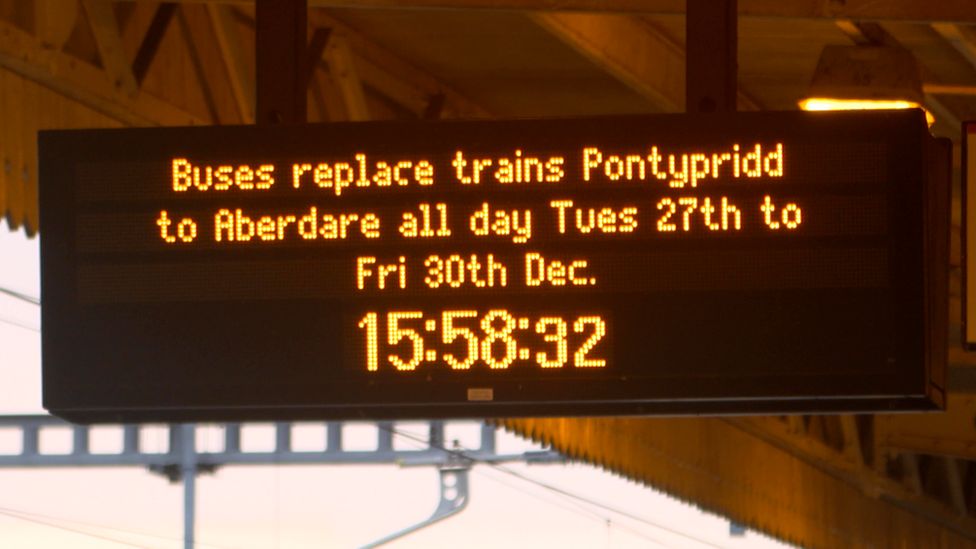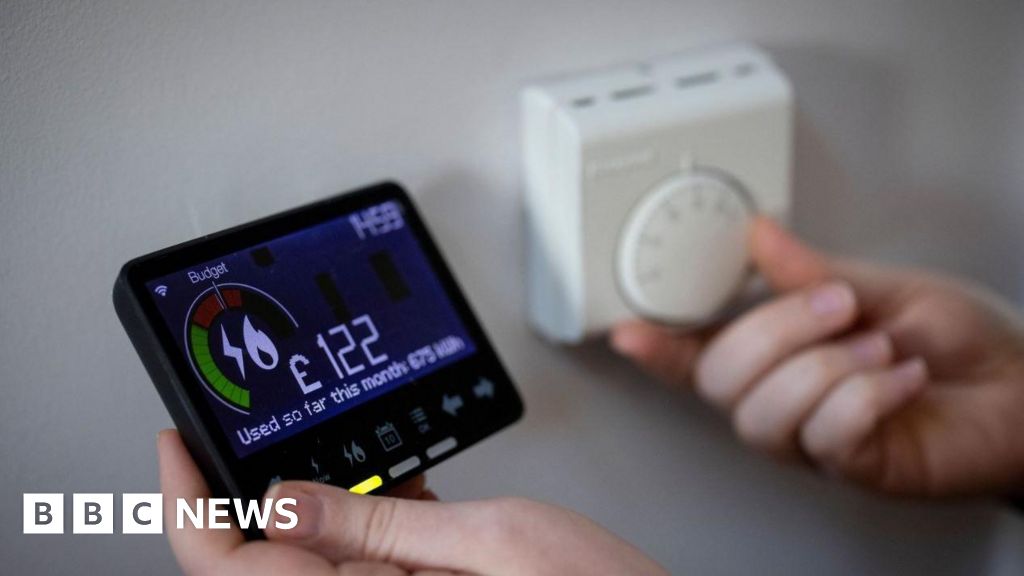ARTICLE AD BOX

Trains in Wales had been beset by problems like overcrowding and unreliability due to a lack of carriages and staff
By Rhidian Thomas
BBC News
Many have had that feeling when your last train home becomes a dreaded rail replacement bus - or even worse, it's cancelled.
And with a record number of UK trains being cancelled, and governments taking control because of poor service or cash issues, some passengers are fed-up.
Now one body is taking what it calls a "unique" multibillion-pound approach to get its railway back on track.
Yet bosses say passengers will suffer "pain" before improvements come in.
As some customers suffer the same old, Transport for Wales (TfW) - who also run trains to Birmingham, Manchester and Liverpool - hopes the first phase of its rail transformation will be done by 2025.
Image source, Transport for Wales
Image caption,TfW operate 1,300 trains a day, on almost 1,000 miles of track as passengers make 20 million annual journeys
Rail chiefs have told a BBC documentary that when TfW's 148 new trains are running, more than 105 miles (170km) of line is electrified, signals and track upgraded and new stations built, passengers in the Wales and Borders area will see "generational" change.
'My journey home will take two-and-a-half hours!'
Most trains run as planned, but try telling that to today's TfW day-trippers, as journeys continue to be disrupted by unreliable old trains - see last week's safety issue as an example - before the new fleet comes into service.
Then there's the frustrated commuters whose journeys between Cardiff and the south Wales valleys are regularly impacted by engineering work and line closures - and you know what that can mean... the bus replacement service.
"I started work at nine this morning, the last thing I want is it to take two-and-half hours to go home," one weary passenger told the documentary that's gone behind-the-scenes at TfW.
"I'm aware there's work going on that'll be a benefit - but it feels quite far away," another commuter said to the How to Fix a Railway cameras.
The last thing these passengers want late at night is to be getting on a replacement bus
Wales' 2050 net zero target and subsequent ban on building new roads has focused ministers' minds on the urgency of their railway revamp and the TfW chief executive, James Price, insists the "pace we are going is very fast in rail terms."
But Mr Price admitted: "People will expect to see change happen almost overnight - it can't work like that.
"You have to go through a period of transformation and sometimes that will mean pain."
What are TfW promising by 2025?
- Bigger and more frequent services, doubling trains on some routes
- Every train replaced, with 95% of journeys on the 148 new trains
- A 65% increase in capacity across the network
- Five new stations
- An increased Sunday service
- Electrification of south Wales valleys services
- More than 600 new jobs
- Better Wifi, more station car parking, smarter ticketing
So why does it take so long?
Just to get a few new trains onto the timetable took almost five years.
That includes finding the cash, designing the trains, awarding the contract to build them, building the factory to build them in, building the trains, inspecting them, and employing and training the drivers to drive them.
A multibillion-pound investment is underway to make Wales' railways bigger, better and faster, and over three years we go behind the scenes as they try to make ambitious promises a reality - with more than a few bumps in the line.
That's just a few trains, let alone the full fleet of 148 which will all go through that process.
Then there's electrification of the lines, which includes lowering track or replacing bridges so electric wires can fit underneath, as the documentary shows how it took 18 months to plan a demolition of one bridge.
Arron SIlva helps lead TfW's engineers as they upgrade and electrify the old south Wales valleys lines
The erection of the 3,000 steel masts to hold up electric wires took years of planning, including "noise mitigation" in an effort to not keep residents living alongside the line awake all night by the installation.
How did Covid affect the rail upgrade?
When the Covid pandemic saw rail travel collapse by 80%, the private firms that jointly won the £5bn, 15-year contract to run the franchise under the TfW banner could not shoulder the financial burden, so the Welsh government stepped in to essentially nationalise Wales' railway.
That meant forming a new organisation to improve and deliver the timetable until 2033, run services and stations and manage staff while also trying to implement Wales' biggest railway regeneration for decades.
"Taking on the operational responsibility for running the railway is a massive challenge - it has radically changed the business that is Transport for Wales," Mr Price told the TV cameras.
Those disruptions affected all TfW engineering projects, including building of maintenance depots and control centres, line upgrades, staff recruitment and the building and delivery of new trains.
Some 77 - more than half - of TfW's new trains are built by CAF at a new £300m factory in Newport.
If that wasn't enough, the firm supplying the problematic new fleet in north Wales - converted from old London Underground District Line trains - went bust before they went into daily service, so TfW now have to also maintain those troublesome trains too.
If the challenge wasn't tough enough, TfW took control of more than 100 miles of the old Valleys lines from Network Rail - the track, signalling, maintenance, leaves... everything.
"What we're doing in south-east Wales is the first time it's been done in the UK," Mr Price said.
The first train built for Wales, in Wales, by Welsh people started running on the Conwy Valley Line in January
"Bringing the track and train under one ownership model and designing things together, not having these convoluted agreements that often cost more than the work we are doing in the end."
When will TfW passengers see the benefit?
Although punters will be forgiven for not noticing yet, there are glimpses of the promised TfW revolution.
After more than four years and billions spent, a few new trains are now in service on the Conwy Valley line in north Wales and also in south Wales..
But there will plenty more rail replacement buses for a couple of years yet, as lines - especially in the south Wales valleys - will need to be closed regularly to allow work to continue.
Image source, Transport for Wales
Image caption,The £8m station at Bow Street, near Aberystwyth, was the first opened by TfW
And as TfW know well, not all engineering work runs smoothly.
"People will expect to see change happen almost overnight," Mr Price told the BBC documentary.
"It can't work like that and you have to go through a period of transformation and sometimes that transportation will mean pain. I use the service myself and experience the bus replacement service. I more than sympathise.
"We're trying to do things differently. Lots of other parts of the UK are looking at what we do because we've taken a lot of risks. We need to deliver to prove ourselves. We need to learn from mistakes that other people have made, realign and put things right."
Like all of TfW's hundreds of new drivers, Neil Davies trained for just under a year to be able to drive the new trains
It's not just the rolling stock that's growing.
TfW's workforce has grown by almost 50% to 3,000 staff, as the organisation looks to put years of negative headlines behind them to deliver the ambitious plans, including the South Wales Metro.
"There's some really difficult things we still need to work our way through," said Mr Price.
"But we are seeing the beginnings of the end of the first chapter of this journey."
Once this phase has left the station, TfW has promised it will be full steam ahead to the next phase of adding new stations, new lines and more services, including the Swansea Bay Metro.
Image source, Transport for Wales
Image caption,The Wales and Border network run by Transport for Wales

 2 years ago
38
2 years ago
38








 English (US) ·
English (US) ·